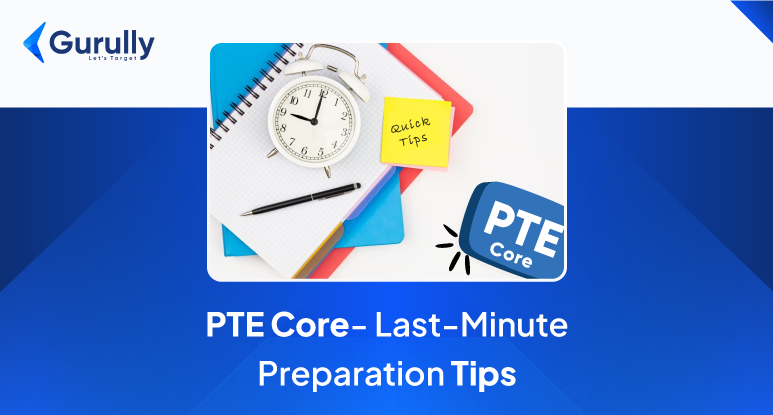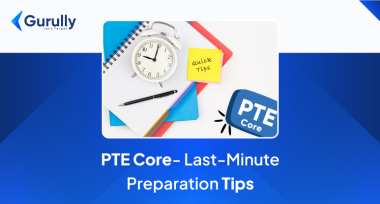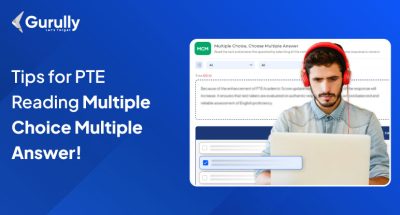Are you tired and confused? Or is this PTE Core practice enough to achieve your target score?
At least once, you would have thought how much more practice you require while preparing for PTE Core. Practice is never enough, but it won’t give you any results if you do not do it strategically. But worry not—we have your back. Even if your test date is creeping closer, there are ways to maximize your performance.
We will share some awesome last-minute preparation tips for PTE Core to help you feel confident. These targeted practice techniques, strategies to manage your time effectively, and some simple ways will help you stay calm and focused during the test.
Here are last-minute preparation tips that will help you throughout your exam journey. Follow them and get your path cleared for the exam.
Understanding the PTE Core Test
What is the PTE Core test?
The PTE Core test is a two-hour, computer-based assessment designed to evaluate your core English skills, including reading, writing, listening, and speaking. This test is particularly significant for those aiming for Canadian immigration, as it is recognized as a valid test for this purpose. The PTE Core test is similar in format to other well-known English proficiency tests like CELPIP and IELTS General. Understanding the latest updates and nuances of the PTE Core test is crucial for achieving your target score and unlocking Canadian opportunities.
PTE Core test format breakdown
The PTE Core test format is structured to comprehensively assess your English language abilities over a span of two hours. The test is divided into four main sections: reading, writing, listening, and speaking. Each section comprises various tasks designed to evaluate different aspects of your language skills. For instance, the reading section might include multiple-choice questions and re-order paragraphs, while the speaking section could involve tasks like describing images and responding to questions. Familiarizing yourself with this format will help you navigate the test more confidently and efficiently.
Key changes in the PTE Core test
The PTE Core test has seen some recent updates, including the introduction of new question types such as “Respond to the Situation” and “Write an Email.” These changes aim to make the test more reflective of real-life scenarios and practical communication skills. Additionally, the test questions in the PTE Core seem to be slightly more lenient compared to PTE Academic, focusing more on content than fluency, especially in the speaking tasks. Staying informed about these changes will help you tailor your preparation strategies effectively.
Review The Format:
The PTE Core is a computer-based exam with four sections: Speaking, Writing, Reading, and Listening. Each section has different question types and time limits. Spend a few minutes reviewing the test format, including the types of questions you’ll encounter and how much time you’ll have for each section. This will help you feel more prepared and confident on test day. Additionally, consider seeking tips for effectively addressing each section to enhance your performance and achieve your desired scores.
Don’t Stress:
We know it is easier said than done, right? But seriously, freaking out won’t get you anywhere. Stress can cloud your thinking and make it harder to perform your best. Instead, take some deep breaths, visualize yourself succeeding in your exam, and remind yourself of all the hard work you’ve put in. A positive and calm mindset will be your best asset on exam day.
Time Management:
The PTE Core is all about time management, and incorporating effective PTE Core tips can make a significant difference. Each section has strict time limits, so knowing how to pace yourself is crucial. Practice watching the clock during mock tests (more on that in a second!), and develop a strategy for each question type. For example, in the Reading section, you might want to spend more time on longer passages and skim through shorter ones.

Get instant AI-powered analysis to track strengths, weaknesses & improve faster
- Personalized AI Insights – Understand your strengths & weaknesses instantly
- Smart Progress Tracking – Monitor improvement with in-depth analysis
- Boost Your Score Faster – Focus only where it matters most
Practice PTE Core exam on mock test:
However, this cannot be considered the last-moment PTE Core practice tips because you must take most tests a week before the exam. Taking practice tests under timed conditions will help you get familiar with the format, identify your strengths and weaknesses, and develop your time management skills.
Things to Remember
- Prioritize Weak Areas – Focus last-minute practice on sections where your scores are low.
- Use Realistic Materials – Stick to PTE-style practice questions, not generic English exercises.
- Short, Frequent Practice – A few focused 30–45 min sessions daily is better than marathon sessions.
- Check Technical Readiness – Make sure your microphone, computer, and headphones are working well for the test, since PTE Core is online.
- Track Progress – Keep a small checklist to mark which sections or question types you’ve practiced.
Section-Wise Practice Tips for the PTE Core
Speaking Section:
- Don’t Panic: If you get stuck on a question, take a deep breath and move on. It won’t affect your score on other questions.
- Focus On Delivery: The test manages time for you, so concentrate on speaking clearly and at a natural pace. Avoid strong accents, and just be yourself in your responses.
- Keep It Flowing: It’s okay to make mistakes; don’t get hung up on them. Just keep talking and avoid correcting yourself in the middle of your answer.
- Practice Makes Perfect: Focused practice on tricky pronunciations, especially similar sounds and singular/plural forms, goes a long way. Practice forming grammatically correct sentences incorporating these words.
- Utilize The Notepad: The erasable notepad is your friend! Use it to jot down key points for tasks like “Respond to a Situation” or “Describe Image.” Writing vertically helps you stay organized and maintain the flow of your thoughts.
- Prepare For Image Descriptions: Familiarize yourself with different image prompts to prepare for anything.
- Train Your Ears: Get comfortable speaking in slightly noisy environments. Practice answering prompts in a crowded cafe or setting to prepare for test day distractions.
Writing Section:
- Time Management is Key for PTE Core: While typing speed is important, focus on managing your time effectively. Practice writing under timed conditions to feel comfortable during the exam.
- Structure is Your Friend: Organize your writing using a clear format, such as an introduction, body paragraphs, and a conclusion for essays. This will make your writing flow smoothly and score well.
- Stay Focused: It’s easy to get sidetracked. Make sure your writing directly addresses the task instructions and avoids going off on tangents.
- Word Count Matters: Be mindful of the word limit for each task. Aim for 5-75 words in summaries written text and 50 10 120 words for Write an Email question type. Sticking to the limit ensures you answer the question completely and avoid losing points.
- Summarize Like a Pro: When summarizing written text, condense the main points into a single clear sentence within the word limit (5-75 words). Use proper punctuation to ensure your summary is easy to understand.
Reading Section in PTE Core:
- Reading Section Time Management: Here are some tips for managing your time effectively in the Reading section. The Reading section is fast-paced, giving you roughly 29-30 minutes to answer all the questions. You’ve likely practiced controlling your time on reading tasks – keep that skill sharp during the actual exam. Don’t get stuck on any one question just move on to the next question.
- Beware of Negative Marking: Some Reading questions have negative markings, meaning you can lose points for wrong answers. Consider carefully before answering, especially for questions that seem easy but might have a hidden trick.
- Grammar Skills Get Tested: The Reading section also assesses your grammar skills. If you have a few spare minutes before the exam, quickly skim through some key grammar rules for a quick refresh.
Listening Section:
- Plan Your Time: The listening section takes 30-43 minutes and has various question types. Budget your time effectively to answer them all.
- Listen Up!: The audio plays only once, so listen carefully and take notes while you hear it.
- Take Notes Wisely: Use the erasable note booklet provided to jot down key points. Remember, don’t spend too much time writing and miss the next part of the audio.
- Score Booster: The listening section can significantly impact your overall score. With good focus and practice, aiming for 70+ is achievable!
- Calming Technique: Consider meditation before the exam. It can improve your focus and help you stay calm while listening.
These tips for PTE Core will help you clear the exam more effectively. To practice for the exams, you can use Gurully. Our platform will provide full-length PTE mock tests with authentic content powered by AI scoring for practice. You can also practice question-wise and section-wise questions to score higher in actual exam.
Responding to a Situation (RTS) in PTE Core
PTE Core sample question for RTS
In the PTE Core exam, you may encounter a task where you need to respond to a real-life situation. This task assesses your ability to understand and react appropriately to everyday scenarios. You will be given a situation to read and listen to, followed by some preparation time and speaking time to formulate your response. Effective time management is crucial for success in this task.
For example, imagine you are taking a regular walk in a garden and notice a group of people littering in the walking zone. You need to address this situation politely and effectively.
To answer this question, you can use the following template:
- Start by acknowledging the situation and expressing your concern.
- Clearly state the problem and its impact.
- Offer a solution or suggestion to resolve the issue.
- End with a polite and respectful tone.
For instance:
“Hello everyone, I hope you are enjoying your time in this beautiful garden. I am a frequent visitor here, and I noticed that some litter has been left in the walking zone, possibly by accident. It would be great if we could all help keep this area clean by picking up any litter we see. Maintaining the garden’s beauty is important for all of us, and your cooperation would be greatly appreciated. Thank you for your understanding and help!”
By following this template and using the right keywords and phrases, you can effectively respond to a situation in the PTE Core exam and demonstrate your English language proficiency.
Conclusion:
While practicing for the PTE Core exam is very important, aimless studying won’t get you far. This guide has equipped you with targeted last-minute PTE Core tips beyond practice tests (which are important but best taken a week before the exam).
We have covered strategies for staying calm, managing your time effectively, and specific techniques for each section: Speaking, Writing, Reading, and Listening. By following these tips, you’ll feel confident and focused on exam day.
FAQ:
Is PTE Core easy to pass?
Is PTE Core accepted?
Is PTE Core easier than IELTS?
What happens if I fail the PTE Core?
How much PTE score is required for Canada?
Also Read:
Free PTE Practice Test:






